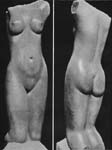
MANKIND BY Eric Gibb
page 16
THE CRAFTSMAN
and Hopton-Wood Stone
Those who carve in stone are, more than any other artist or craftsman, at the mercy of their material. A painter can discard, in the very middle of his work, a pigment that has failed him and procure another; a composer of music, if he cannot reach his effect with the means to hand, may call for any instrument he desires to augment his orchestra; a poet . . . but there is no need to labour the contrast between these free men and him whose medium is unmerciful, allowing no second thoughts, no painting out, no change of key, no proof revision. Even the carver of wood, because the piece will usually he smaller and so more confidently
chosen, is spared the chagrin of that artist who, after hours of labour, encounters in the heart of his stone an irremediable fault.
There are stones which have immediate beauty, yet are useless to the sculptor: too soft, too coarse, too unreliable, they give more trouble than they are worth, Beauty in stone must be much more than skin-deep if it is to stand up to the graver and chisel. Beauty, indeed, must join the queue with other characteristics equally important.
What are the characteristics of Hopton-Wood? First, it is a hard and consistent stone, of a compact and crystalline texture with even markings caused by symmetrical crinoids or 'sea lilies'. Second, it will take a brilliant polish and it is an English stone which is so uniform, that it may be matched, piece for piece, with an exact similarity of tint and texture. Third, Hopton-Wood is obtainable in two colours, the Light being a rich
page 17
PANELS ON THE MOOT HALL, WIRKSWORTH
warm cream, and the Dark, having more encrinities, a deeper version of the other. Fourth, age does not impair its consistent colouring; and, provided our advice is sought for bedding and backing, the surface of the stone will never stain or powder.
Monumental and architectural carvers appreciate the wearing qualities of Hopton-Wood. The same sharp arris that the artist leaves will be as clean to the eye of many generations to come. One hundred and thirty years ago the facade of the Moot Hall at Wirksworth was embellished with panels of Hopton-Wood bearing the symbols associated with the ancient office of Barmaster. Today, despite exposure to the rough climate of the Derbyshire mountains, they are as clear-cut as the day they were put up, in sharp contrast to the scaling wall behind them.
For those who desire to erect a memorial of enduring beauty, Hopton-Wood cannot be excelled. As small tablet or heroic statuary, as a headstone or a mausoleum, this lovely stone will fulfil every conceivable requirement. It is a co-operating stone and responds to the mood of artist or craftsman: reverential for solemn usage yet charming as an object of virtu, handsome
page 18

THEIR SHARP ARRIS CONTRASTS WITH THE SACALING WALLS
for domestic embellishment (as, for example, a fireplace) and as subtle as any sculptor cares to make it.
As for general interior work, Hopton-Wood is ideal not only for plain wall-linings, as well as for stairs and pavings, but also in all those decorative uses, such as balustrades, ornamental columns and pilasters, where the craftsman's skill may achieve breadth or delicacy in a stone of almost infinite range.
When so many well-known artists have used Hopton-Wood it might be invidious to name a few, yet it would be ungrateful to close this brief account of the stone without a tribute to the memory of that consummate artist and craftsman, Erie Gill, who made Hopton-Wood peculiarly his own. A lover of fine lettering, Gill used Hopton-Wood for much of his best inscriptive work; a master of bas-relief, his Stations of the Cross in Westminster Cathedral demonstrate conclusively his preference for HoptonWood; a sculptor of many lovely pieces, his Hopton-Woods seem to be the ultimate flowering of his genius. So fastidious a craftsman would not have tolerated a stone that did not satisfy explicitly all the exacting canons of his difficult art.
page 19
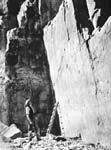
Gauging the face
page 20
REDUCING A NEWLY FELLED BLOCK, EXPERTS IN CONFERENCE
TURNING THE BLOCK
SPLITTING THE BLOCK,
SCAPPLING
page21
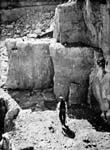
Getting to work
page 22
USING HOPTON-WOOD
THE BANK OF ENGLAND: CARVED GRILLE. Sir Herbert Baker, RA, and A.T. Scott, FRIBA
page 23
WELSH BOARD OF HEALTH, CARDIFF: WALL LININGS, PAVINGS HM Office of Works
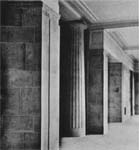

THE BANK OF ENGLAND picture THE BANK OF ENGLAND
page 24
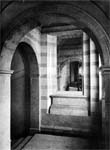
THE CITY HALL, SHEFFIELD: WALL LININGS E. Vincent Harris, RA.
THE CIVIC BUILDING, LEEDS: WALL LININGS, FIREPLACE E. Vincent Harris, RA
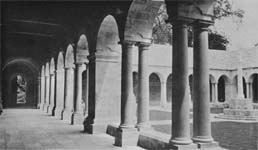
WINCHESTER COLLEGE : CLOISTERS< CROSS AND PAVING Sir Herbert Baker, RA
page 25
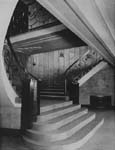
POLICE COURT, DERBY: WALL LININGS C. H. Aslin, FRIBA
page 26
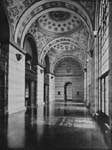
THE CITY HALL SHEFFIELD: WALL LININGS E. Vincent Harris, RA
page 27
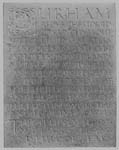
INCISED PANEL Gilbert Ledward, RA
page 28
CARVING HOPTON-WOOD

THE SOWER, BROADCASTING HOUSE Eric Gill
page 29
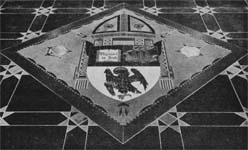
LIVERPOOL, CATHREDRAL: PAVEMENT Sir Giles Gilbert Scott, RA
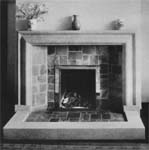
FIREPLACE, KERB AND BREAST
page 30
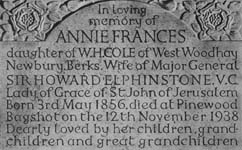
ELPHINSTONE TABLET, BAGSHOT Edmund Ware, FRBS
THE CITY HALL, SHEFFIELD: Lions John Hodge
page 31
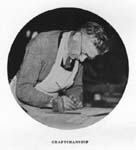
CRAFTSMANSHIP (Webmasters Note; the craftsman has been identified as Bert Petts by his
granddaughter Sue Julian. He is working in the Preston End. Her father Laurie Petts also worked at Middleton)
page 32